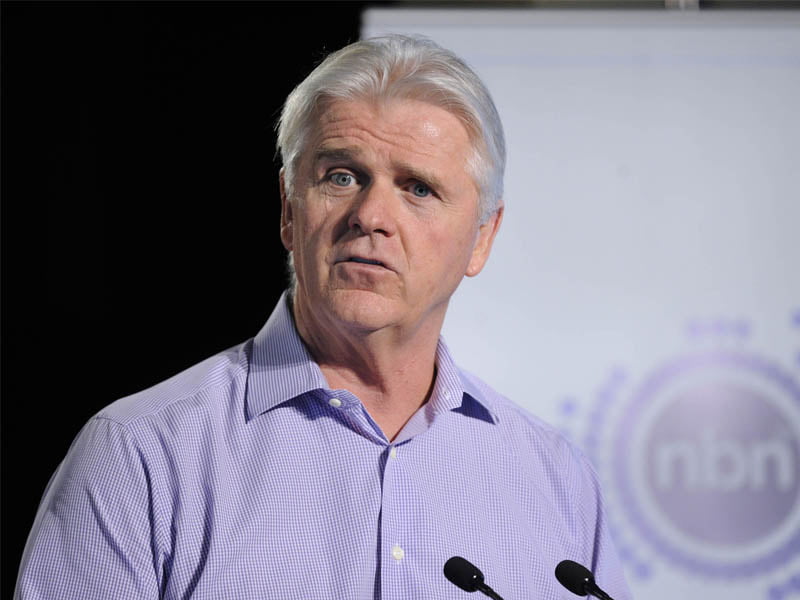NBN Co’s half year results released on Monday provide confirmation that the National Broadband Network (NBN) is a train wreck and there is nothing that can be done to get it back on the rails.
Increasingly, statements emanating from NBN Co about performance and progress are little more than fodder for the joke of the day.
In a stunning admission just minutes after presenting the half year results, NBN Co chief executive Bill Morrow admitted that the company would “miss its long-term revenue target of $52 per user.”
So why do the half year results indicate that this unattainable goal is still one of the 2020 key targets?

Mr Morrow appears to blunder when he told The Australian that “NBN Co would have to revise its target of hitting average revenue per user (ARPU) of $52 by 2021, saying the move was needed to accommodate recent changes made to NBN Co’s wholesale pricing structure.”
This is not the first time that Mr Morrow has gone off message and indicated that NBN Co would not achieve the rollout deadlines and financial targets by 2020.
Shadow Communications Minister Michelle Rowland was quick off the mark to point out that Mr Morrow was also quoted as saying that “he is considering building a 5G wireless network to bypass parts of the copper NBN that are unreliable or corroding.”
If Fibre to the Node (FTTN) was deployed in areas where the 5G wireless network is to be rolled out the cost per premises would be about $6000, which is $2500 more than what it would have cost for Fibre to the Premises (FTTP), which is a technology with a 50 to 80 year lifetime, low latency, high reliability and a cheap upgrade pathway to 10 Gbps connections and higher.
Ms Rowland also pointed out that the half yearly results did not appear to include the $420 million to $790 million in additional costs identified by NBN Co at the end of 2017 resulting from the halt to new Hybrid Fibre-Coaxial (HFC) connections.
NBN Co included $450 million in additional costs to the HFC rollout in the half year results and it is likely that this figure will increase when the full year results are released in early August.
In another blow for NBN Co, the Bill Morrow was forced to admit late last year that only about 25 per cent of premises connected to the NBN using Fibre to the Node (FTTN) will be able to receive 100/40 Mbps or higher. About 60 per cent of all premises connected to the NBN will be connected with FTTN.
Many of the FTTN and HFC customers have already experienced poor reliability, dropouts and problems when it rains.
In response, NBN Co states in the half year 2018 results that it will provide a “greater focus on customer experience.”
What this means in practice will be further rollout delays whilst NBN Co responds to the huge increase in customer complaints lodged with retail service providers and the Telecommunications Industry Ombudsman.
Ms Rowland dead-panned that “this is not a multi-technology mix — it’s a multi-technology mess.”
NBN Co identified more than five years ago, when it was rolling out the higher quality, more reliable FTTP, that the ARPU would need to increase from the initial $40 per customer per month to about $53 per customer per month if the revenue was to be raised to pay back the Government’s investment in the NBN.
This target was always going to be ambitious, but it may have been achieved as residential and business customers were brought onto fibre and provided with services that justified the expenditure for higher speed connections.
NBN Co’s 2020 key targets include having the build “100 per cent completed, 8 million premises connected and $5 billion in revenue.”
Why did NBN Co bother to include the 2020 key targets? Was it to remind us that NBN Co was not going to achieve them? Mr Morrow appears certain that the 2020 key targets won’t be achieved and most Australian telecommunications experts agree with him.
In the seven years since the NBN rollout commenced, ARPU has moved from about $40 per customer per month to the $44 per customer per month announced in the half year 2018 results. In the next two and a half years, NBN Co would have us believe that it aims to boost this figure to $52 per customer per month.
Now this mountain might have been surmountable if NBN Co had stuck with the original plan to rollout the world class FTTP, with its lower maintenance and operational costs and as a foundation for ‘5G everywhere’. But the reality is starkly different.
NBN Co is trying to sell customers the idea that a second rate NBN utilising obsolete FTTN that provides the majority of customers with a very poor experience, poor reliability and slow connection speeds.
To add to NBN Co’s woes, the mobile operators are getting ready to rollout 5G over the next couple of years and 5G will be far superior to FTTN. Hence Mr Morrow’s statement earlier that he is considering using 5G in areas where FTTN would be worse than it already is.
By 2020, mobile operators are likely to offer 200 GB plans with 1 Gbps connection speeds for a price similar to the discounted 50/10 Mbps plan on offer from NBN Co today.
NBN Co’s prediction in the 2018 to 2021 Corporate Plan that about 15 per cent of customers will opt for mobile broadband rather than connecting to the NBN was overly optimistic.
Customers will not use the NBN if their going to get a substandard broadband connection at an unjustifiably high price.
It is likely that 20-30 per cent of customers will move to 5G fixed or mobile broadband connections.
This prediction is nothing new, I wrote about this several times in recent years in concert with warnings from other Australian experts. If this was not enough, a recent survey by Venture Insights identified that up to 30 per cent of premises could move to wireless broadband connections between now and 2040.
For NBN Co, even an additional 5 per cent of premises moving to wireless broadband would put the companies bottom line in peril.
NBN Co’s business model is broken, and the half year 2018 results is yet another carefully crafted document that hides the underlying problems facing NBN Co.
To add to the positive mantra, NBN Co has identified an upgrade pathway from FTTN and Fibre to the Curb (FTTC) to G.Fast. What NBN Co doesn’t provide in the half year results is any indication of the cost of the upgrade, the cost to decommission the FTTN, and performance data on what customers would gain from G.Fast.
FTTN is already obsolete, so when is NBN Co planning to replace it with G.Fast? And why not simply move from FTTN to FTTP as New Zealand did?
The NBN is about the future of this nation as a participant in the global digital economy and it is about jobs, just as it is about connecting families to the Internet.
To highlight why the NBN is already a failure, it is reasonable to look forward to 2020 to see what other nations will enjoy over their broadband.
The Tokyo Olympics aims to stream the telecast using 8K television. The standards indicate that reasonable quality 8K can be achieved using between 200- 300 Mbps per channel.
The NBN is not just about entertainment, but if you consider that business, health, education and other applications keep pace with the incremental jumps in data required for entertainment, then it becomes clear that Australia is fast becoming a third world broadband nation.
NBN Co’s half year results are important, not for the headlines, not for the hype and spin, but for what has been left out, and the lack of answers to key questions. The results highlight why the NBN is a lemon.
The figures provided by NBN Co don’t tell the whole story and the glowing predictions of a successful outcome that everyone will be satisfied with are looking more astounding every day.
Dr Mark Gregory is an Associate Professor in the School of Engineering at RMIT University and is the Managing Editor of the Australian Journal for Telecommunications and the Digital Economy.
Do you know more? Contact James Riley via Email.

